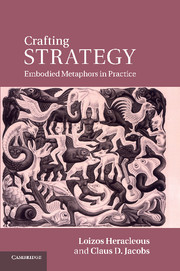Book contents
- Frontmatter
- Contents
- List of figures
- List of tables
- Preface
- Acknowledgments
- Vignette A BASF PerForm
- Vignette B UNICEF
- Vignette C Project Voltigo
- 4 Crafting strategy as a practice of embodied recursive enactment
- 5 Play, analogical reasoning and dialogue in the crafting of strategy
- Vignette D Hephata Foundation
- Vignette E Privatbank IHAG Zürich AG
- Vignette F World Vision New Zealand
- Glossary
- Index
- References
4 - Crafting strategy as a practice of embodied recursive enactment
Published online by Cambridge University Press: 05 June 2011
- Frontmatter
- Contents
- List of figures
- List of tables
- Preface
- Acknowledgments
- Vignette A BASF PerForm
- Vignette B UNICEF
- Vignette C Project Voltigo
- 4 Crafting strategy as a practice of embodied recursive enactment
- 5 Play, analogical reasoning and dialogue in the crafting of strategy
- Vignette D Hephata Foundation
- Vignette E Privatbank IHAG Zürich AG
- Vignette F World Vision New Zealand
- Glossary
- Index
- References
Summary
Before elaborating our approach of crafting strategy and drawing on Sennett's (2008) recent analysis, we first reflect on the notion of craftsmanship in a socio-cultural context. Then and in extending the metaphorical view of strategy as craft, we conceptualize crafting as an actual practice of strategy. Situating our approach within the practice-based view of strategy (e.g. Jarzabkowski, 2005; Whittington, 2006), we discuss how integrating three foundational domains, namely physiological, psychological and social constructionist perspectives, lead us to conceptualize crafting strategy as embodied recursive enactment. We demonstrate this conceptualization through the case of strategy work at Orange UK in the early 2000s.
“Making is thinking” – reflections on craftsmanship from a cultural materialist perspective
Crafting as the skill of making things well
While traditionally we associate craftsmanship with a pre-industrial, manual worker involved in making singular objects, such as a medieval carpenter, Sennett refers to craftsmanship more generally as “the skill of making things well” (2008: 8). In his compelling analysis, he acknowledges the relevance of crafting technique, but beyond this considers craftsmanship as “an enduring, basic human impulse, the desire to do a job well for its own sake” (2008: 9). Such an impulse is not limited to ancient manual workers but similarly applies to such diverse occupations as contemporary artists, doctors, laboratory technicians or computer programmers, or such different domains as bricklaying, cooking, playing the piano or analyzing a chemical substance.
- Type
- Chapter
- Information
- Crafting StrategyEmbodied Metaphors in Practice, pp. 65 - 89Publisher: Cambridge University PressPrint publication year: 2011



